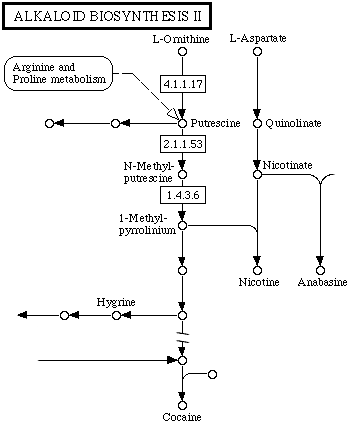
(Click on image to enlarge [1])
DRUG [3] |
% who get addicted
after trying |
Tobacco |
31.9 |
Heroin |
23.1 |
Cocaine |
16.7 |
Alcohol |
15.4 |
|
 |
|
|
Tobacco Users Smoke Crack
Recently uncovered internal tobacco industry memos and reports reveal that industry executives knew of the addictive nature of nicotine
long before they disclosed this information to the public. In this profiled document [1], industry researchers
discuss the similarities between nicotine, the addictive
chemical in tobacco products, and drugs like cocaine, heroin and marijuana. Although the industry knew -- more than 30 years ago --
of the highly addictive nature of modern tobacco products, few people are aware that smoking cigarettes is similar
to smoking crack cocaine.
The graphic at left illustrates the biosynthesis of alkaloids. Common alkaloids are cocaine, heroin and nicotine. As seen in the
expanded illustration, nicotine and cocaine are very close "cousins" [2].
The media, and our society in general, place great emphasis on the negative social aspects of illicit substances like
cocaine and heroin. Yet, as this evidence shows, nicotine and cocaine are essentially the same drug.
More importatntly, the table at left highlights the superior addictiveness of nicotine.
Tragically, one quarter of the U.S. population functions daily only by taking hundreds of "hits" from a highly addictive chemical. This
drug alters their mental functions, corrupts rationality, and literally, takes control over lives.
|
|
"We solemnly swear..."
In 1994 tobacco industry executives stood before the U.S. Congress and testified UNDER
OATH that cigarettes are not addictive. Since the 1970s, tobacco companies knew that nicotine, found naturally in tobacco plants,
is highly addictive, and more importantly, that it could be manipulated to increase the popularity of their cigarettes [see
Philip Morris letter, RJ Reynolds document].
In a 1977 Philip Morris document, author W.L. Dunn instructs T.S. Osdene that the Philip Morris scientists will
bury the results of a study on nicotine if the outcomes prove similar to "morphine and caffein" (sic)
[read document]. The tobacco industry has known for decades
that nicotine is a highly addictive drug. The paragraph below comes from a RJ Reynolds document:
Most cigarette smokers begin smoking at an early age. They smoke for some period, attempt to quit, but then relapse.
This sequence is similar to that for drugs of abuse. For example, both the opium and tobacco habits develop quite
rapidly. Cocteau's dictum, regarding opium smoking, that "he who smoked will smoke," is equally true for tobacco
smoking. In both cases, simple exposure to the substance ("experimentation") usually leads to repeated and then
chronic use. To the extent that experimentation leads to chronic use, tobacco appears to have "an addictive potential"
similar to that of opium. [ RJ Reynolds Document p2]
America's Kids Are Crack Addicts...
Over 80% of smokers become addicted to tobacco and nicotine before they
reach the age of 18 ( Learn More About Nicotine). As a society, we tolerate youth smoking. We believe, falsely, there are
worse problems. This myth has been perpetuated in part by the tobacco industry. The table below lists the
annual death toll in the US, Britain and Australia due to addictive drugs: tobacco, alcohol and all the illicit drugs
combined (powder and crack cocaine, heroin, and others) [4].
|
TOBACCO |
ALCOHOL |
ILLICIT DRUGS |
Annual Death Toll |
Annual Death Toll |
Annual Death Toll |
U.S. = 450,000 |
U.S. = 81,000 |
U.S. = 14,000 |
U.K. = 120,000 |
U.K. = 40,000 |
U.K. = 3,000 |
Australia = 19,019 |
Australia = 3,271 |
Australia = 1,023 |
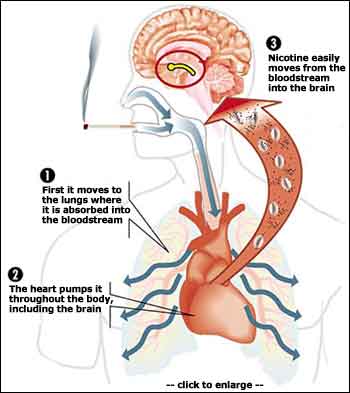
For a drug to be addictive, it must get to the brain quickly. Injected heroin gets to the brain in
about 15 seconds, giving the user an explosive "high." Nicotine from tobacco smoke gets there even faster. It takes
about seven (7) seconds to travel from the lungs to the brain -- (see
special on How Tobacco Companies Free-base, or Super Charge, Nicotine).
Once in the brain, nicotine minics a chemical called acetylcholine and bonds with nerve cells scientists refer
to as "nicotine receptors." These receptors are "entry gates" to the cells and the specific chemicals activate
the receptors. The chemicals "fit" the receptor cells like a key sliding into a lock.
We call these chemicals neurotransmitters.
They function as a postal system for the brain by delivering instructions to different cells and
causing chemical reactions to occur [5].
Nicotine "hijacks" many of the receptors meant to receive acetylcholine and causes the release of
other chemicals such as dopamine, serotonin and noradrenaline. These reactions create the "high" associated with
smoking. The neurotransmitters make the smoker feel happy, alert or stimulated and affect the mood of the addicted
user [6].
Getting "high" on Nicotine
Researchers believe smoking causes an increase in the amount of "feel good" chemicals present in the smoker's
brain. As the person continues to smoke, his/her brain actually creates more nicotine receptors with which to
"catch" the drug. This means that when the smoker stops smoking abruptly, all these receptors become "hungry"
for their habitual dose of nicotine. This hunger is responsible for the physical cravings for a cigarette. The
sudden drop in the levels of dopamine and other neurotransmitters in the smoker's brain when he/she quits result
in low moods and depression that so many people experience when they try to quit [7]. The crack cocaine user goes
through similar, although more intense, withdrawals upon cessation: the initial short-lived euphoria will be followed
by a "crash." This involves anxiety, depression, irritability, extreme
fatigue and possibly paranoia.
Exerts from: "Nicotine Addiction in Britain: A report of the Tobacco Advisory Group of the Royal College of Physicians,"
RCP Publications, February 2000
Cigarette smoking should be understood as a manifestation of nicotine addiction, and that the
extent to which smokers are addicted to nicotine is comparable with addiction to 'hard' drugs
such as heroin or cocaine. This conclusion has fundamental implications for the design and
implementation of public health policy on the control and prevention of cigarette smoking.
9.1 Tobacco and nicotine addiction
The unique selling point of tobacco is its nicotine content - tobacco products without nicotine
are not commercially viable. Nicotine is an addictive drug, and the primary purpose of smoking
tobacco is to deliver a dose of nicotine rapidly to receptors in the brain. This generates a
pleasurable sensation for the smoker which, with repeated experience, rapidly consolidates into
physiological and psychological addiction reinforced by pronounced withdrawal symptoms.
The presence of nicotine is necessary, but not sufficient, for the nicotine to have a powerful
psychoactive impact. To achieve the latter, nicotine must also be delivered rapidly to the brain.
Tobacco smoke inhalation is the most highly optimised vehicle for nicotine administration because
absorption through the lungs delivers nicotine to the brain rapidly and intensively. The potency
of the nicotine effect is created by the speed of delivery, not just by the total nicotine delivered.
The speed of nicotine delivery is a fundamental difference between cigarettes and nicotine
replacement therapy (NRT) products which deliver nicotine at lower and slower subaddictive rates.
For this reason, nicotine delivered through tobacco smoke should be regarded as a powerfully
addictive drug, and smoking as the means of nicotine self-administration. The risk of addiction
to NRT products is very low, but they are effective in attenuating cravings and withdrawal from
tobacco-delivered nicotine dependence.
In its usual dose range, nicotine use does not cause intoxication or intense euphoria, but
does have a complex physiological impact which creates dependency reinforced by withdrawal.
The fact that nicotine does not intoxicate does not make it less addicting, but may explain
why medical bodies and governments have not generally recognised tobacco use as a form of
drug addiction or dependence. It is far from clear that benefits attributed to nicotine use
such as stress relief, improved mood and enhanced cognitive performance are real. Many
perceived benefits are actually attributable to the relief of nicotine withdrawal symptoms.
Although nicotine in the form of tobacco is a legal drug, it should not be regarded as
pharmacologically benign. The classification of drugs as 'legal', 'soft' or 'hard' reflects
public perceptions and current law enforcement practice, rather than constituting a useful
pharmacological classification. In terms of addictiveness, nicotine delivered in tobacco smoke
is a 'hard' drug on a par with heroin and cocaine. The status of nicotine as a seemingly innocuous
legal drug, and attempts for many years by the tobacco industry to equate addiction to nicotine
with addiction to substances such as coffee, colas or chocolate, have distracted attention from
the highly addictive nature of nicotine in cigarettes.
9.2 Consequences of nicotine addiction
The principal adverse consequences of nicotine addiction are the morbidity and mortality caused
by active and passive smoking. Nicotine addiction is the primary reason why smokers find it
difficult to give up smoking. Most people begin smoking and become addicted to nicotine as
teenagers. This addiction may then cause tobacco use to continue long after an informed adult
choice has been made to stop smoking on the grounds of a change in attitude to health, changed
circumstances such as starting work in a smoke-free office, starting a family or other reasons.
This characteristic of tobacco use - an attenuation of free choice initiated in childhood - is a
central plank of the case for government intervention to control tobacco use through measures such
as advertising bans, tax increases, anti-smoking communications and cessation support, and to
regulate the availability and safety of nicotine products.
Nicotine addiction is closely linked to socio-economic disadvantage. Smoking prevalence is
higher and nicotine use heavier among poorer smokers. The socio-economic gradient in smoking
behaviour accounts for about two-thirds of the excess premature mortality associated with
deprivation. Nicotine addiction is therefore responsible for significant health inequalities.
An addicted brain is altered by the drugs -- it becomes physically different as well as chemically different from
a normal brain. A cascade of neurobiological changes accompanies the transition from voluntary to compulsive drug use,
but one of the most important is this: cocaine, heroin, nicotine, amphetamines and other addictive drugs alter
the brain's pleasure circuits. Activating this circuit, also called the reward circuit, produces a feel-good sensation.
Eating cheesecake or tacos or any other food you love activates it. So does sex, winning a competition, acing a test,
receiving praise and other pleasurable experiences. The pleasure circuit communicates in the chemical language of
dopamine: this neurotransmitter zips from neuron to neuron in the circuit like a molecular happy face, affecting
the firing of other neurons and producing feelings from mild happiness to euphoria [8].
For more on nicotine addiction, see special on Why Does Smoking So Often Produce Dependence?
A Somewhat Different View.
Nicotine v. Cocaine
To understand drugs like cocaine and nicotine, researchers at Massachusetts General Hospital recruited cocaine addicts
who had been using for an average of seven to eight years and had used on 16 of the past 30 days. The test subjects
were given a "party" dose of cocaine, up to about 40 milligrams for a 150-pound man. Using a fMRI, the researchers took
snapshots of their brains every eight seconds for 18 minutes (see Illustration below). At first, during the "rush" phase,
the addicts described
feeling "out of control," as if they were "in a dragster" or "being dangled 10 feet off the ground by a giant hand." They
also felt a high, a surge of energy and euphoria. The fMRI showed why: cocaine made a beeline for the pleasure circuit,
turning on brain areas called the sublenticular extended amygdala and nucleus accumbens and keeping them on [9].
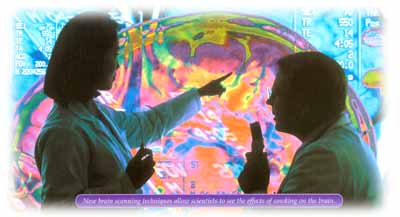
|
|
"Drugs of abuse increase the concentration of dopamine in the brain's reward circuits," says Nora Volkow of Brookhaven
National Lab. The drugs do that more intensely than any mere behavior, be it eating a four-star meal or winning the lottery.
But each drug turns up this feel-good neurochemical in a different way:
Cocaine [and nicotine] block the molecule that ordinarily mops up dopamine sloshing around neurons. When all the seats on this so-called
transporter molecule are occupied by cocaine [or nicotine], there is no room for dopamine, which therefore hangs around and keeps the
pleasure circuit firing. The intensity of a cocaine [or nicotine] high is directly related to how much of the drug that
ties up the seats on the transporter bus [10]. Images sources: STOP! Magazine (Jan./Feb. 2001).
|
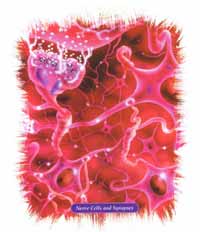 |
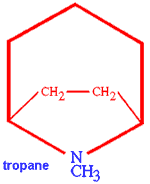 |
Stimulant alkaloids such as nicotine from tobacco (Nicotiana tabacum) and cocaine from
coca (Erythroxylum coca) are highly addictive and clearly alter one's mental and physical state.
The starting compound of this synthesis is ornithine, methylornithine
is the first intermediate. A common property of tropane alkaloids is a methylated nitrogen atom N-CH3 at one end of
the molecule (see illustration at left). This chemical structure is also found in the
neurotransmitter acetylcholine, which transmits impulses between nerves in the brain and
neuromuscular junctions. The anesthetic properties of tropane alkaloids may relate to their
interference with acetylcholine, perhaps by competing with it at the synaptic junctions, thus
blocking or inhibiting nerve impulses [11].
|
Without getting into complicated anatomy and physiology, one nerve cell (neuron) connects
to an adjacent neuron by a long extension called an axon. The axon branches into axonal
endings, each of which attaches to the adjacent neuron at a synaptic knob filled with
acetylcholine. The minute gap or synaptic cleft within this knob is only about 0.02 micrometers.
As a nerve impulse (wave of depolarization or action potential) reaches this gap, acetylcholine
diffuses across the synaptic cleft and activates the adjacent neuron. Acetylcholine in the synaptic cleft is deactivated or broken
down by the enzyme acetylcholinesterase, thus shutting off the action potential. Organophosphate insecticides, such as malathion
and parathion, bind to active sites on this enzyme, thus preventing the normal shut down of nerve impulses and destroying the
nervous control of insects. Nerve gasses developed during World War II have a similar effect on the nervous system. Gulf War
soldiers carried an atropine syrette to counter the possible effects of nerve gas [12].
The illustration below contrasts the chemical structures for both cocaine and nicotine. Cocaine
is more complex, but it begins as does nicotine with the N-CH3 methylated nitrogen
atom at the end of the molecule. One way to think about the two compounds is that nicotine is
like drinking a beer while cocaine is like downing a straight shot of whiskey -- both have
a great potential of seriously harming the user. More importantly, smokers are unaware that the
tobacco companies routinely add ammonia to cigarettes. Ammonia works to release the extra, or
unused, nicotine resulting in a "free basing" effect that provides a "super-charged" kick of nicotine -- (see
special on How Tobacco Companies Free-base Nicotine.
The nicotine hit becomes significantly more potent, i.e., similar to free basing powder cocaine, or smoking crack cocaine,
rather than just snorting powder cocaine. 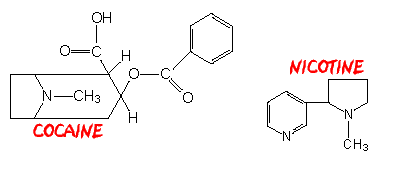
Cigarette Smoking Linked To Miscarriages and Other Problems, Worse Than Crack Cocaine
The similarities between smoking cigarettes and crack cociane have been available for some time, but we have been unwilling to face the truth about tobacco abuse. A study published in December 1998 confirmed the link between smoking and miscarriages, showing that 80 percent more miscarriages occur among women who smoke cigarettes.
The study, led by Dr. Roberta Ness of the University of Pittsburgh, examined
the drug use of nearly 1000 Black inner-city women. The results show that
smoking cocaine was responsible for eight percent of the miscarriages and
smoking cigarettes caused 16 percent.
The abuse of illicit drugs like crack cocaine by pregnant women has received
more attention, but experts say the common, legal drugs -- alcohol and nicotine
-- present some of the greatest dangers to unborn babies. "It's our
legal substances that are killing us," said Harvey Siegal, director
of substance abuse treatment programs at Wright State University.
"The biggest substance abuse we have to deal with is not crack, it's not cocaine, it's not alcohol -- it's smoking," said Dr. Jeffrey King, medical director for Born Free, Miami Valley Hospital's program for pregnant substance abusers. "I'll deal with the crack and the alcohol if we could get people to stop smoking." Alcohol rehab has been a solution to many abusers, but there is no cigarette rehab to be fair.
Cigarette smoking by pregnant women can cause spontaneous abortion, prematurity, sudden infant
death syndrome, and asthma and other respiratory problems for babies, King noted. "We see
younger and younger girls smoking and smoking regularly," he said. "Many smoke through
pregnancy after pregnancy" [13].
A January 2001 study by researchers at the University of Alabama at Birmingham documented
how cigarette smoke exposure in the perinatal period increases the risk of various prenatal
and postnatal complications, including sudden infant death syndrome (SIDS) and persistent pulmonary
hypertension of the newborn (PPHN) [14]. In a related February 2001 release of the result from a study
conducted in Denmark, the researchers found maternal smoking during pregnancy and a low prepregnancy
body mass index are associated with a higher risk of hospitalization with infectious disease
during early childhood. These associations are independent of fetal growth indicators [15].
Shockingly, in a March 1999 study, researchers found a dose-response relationship between amount of maternal prenatal
smoking and arrests for nonviolent and violent crimes. Children born to mothers who smoked during prenatal
particularly related to persistent criminal behavior rather than to arrests confined to
adolescence. These relationships remained significant after the resesarchers controlled for confounding
potential demographic, parental and other perinatal risk [16]. The combined results from these
and other studies illustrate the dramaticly similar effects between maternal crack cocaine and
nicotine use and prenatal development.
Fetal Cocaine Exposure: A Comparison to Nicotine
Cocaine shares a number of key characteristics with nicotine. Both are vasoconstrictors that converge on
adrenergic neurotransmission as their underlying mechanism, nicotine by evoking catecholamine release and cocaine by preventing
presynaptic uptake of catecholamines, thus intensifying their activities. Therefore, cocaine, like nicotine, is capable of
evoking acute episodes of fetal hypoxia-ischemia [17].
Likewise, both cocaine and nicotine are anorexic drugs and thus influence maternal nutritional state. A schematic
for cocaine's impact on fetal development would resemble that of nicotine, without the participation of tobacco
byproducts, but with much heavier emphasis on risky behaviors, poor prenatal care and socioeconomic status. Perhaps most
importantly, co-abuse of tobacco is an invariable component in the use of crack cocaine. The illustration below highlights
the variables that contribute to the adverse perinatal outcomes from maternal cigarette smoking [18].

Cocaine use differs from that of tobacco/nicotine, however, in that it tends to be episodic rather than continuous. An
appropriate animal model for cocaine use therefore should involve repeated, acute exposure rather than continuous
infusions [19]. Accordingly, we have utilized daily injections of cocaine to pregnant rats at a dose that simulates plasma levels found
in crack cocaine users. This regimen has already been shown to cause CNS functional and behavioral alterations in the
offspring [20].
Fetal cocaine exposure, similar to nicotine, elicits postnatal elevations in CNS ornithine decarboxylase activity, indicative
of cell damage [21]. The illustration below contrasts the effects of prenatal exposure to nicotine by
infusion and cocaine by injection. Although both nicotine and cocaine elicit evidence of cell damage (elevated ornithine
decarboxylase, ODC), the effect of nicotine is more persistent. Nicotine, but not cocaine, produces
deficits in the number of cells -- evidenced by reduced DNA content. However, the effects are smaller in magnitude than those of
nicotine and do not manifest persistence into the second postnatal week. More importantly, cocaine exposure does not lead to
irrevocable cell loss, as shown by maintenance of normal DNA content [22].

Researchers expected were therefore surprised to find that a single injection of cocaine to neonatal rats does inhibit DNA synthesis acutely
[23]. The effects differ from those of a single injection of nicotine in two regards. First, there is no regional
selectivity to the effect of cocaine, whereas the effect of nicotine follows the distribution of nicotinic cholinergic receptors.
Second, the effects of cocaine are extremely short-lived, disappearing within 4 hours of administration, whereas the
effect of nicotine is persistent. The graphic below highlights the regional selectivity and persistence of effect from a single
injection of nicotine or cocaine on DNA synthesis in neonatal rat brain. While both drugs
cause acute inhibition of DNA synthesis within the first 30 minutes post injection, only the effect of nicotine is
regionally selective, favoring regions that have high nicotinic receptor concentrations.
Cocaine elicits uniform inhibition across all regions. The effect of nicotine persists through four hours after
the administration of the drug -- whereas the effect of cocaine does not.

These findings suggest a greater impact from nicotine than cocaine on cellular development. Exposure
to nicotine from continued infusions results in depressed DNA synthesis for an extended period. The episodic exposure to
cocaine allows the DNA synthetic rate to recover between injections, thus reducing cell loss -- although there is still evidence of
cell damage, but significantly less than that observed with nicotine.
Smokers tend to maintain plasma nicotine levels at a constant value. Cocaine is used in "jags" with extended periods of non-use.
Given the much shorter plasma half-life of cocaine, there is a much greater opportunity for fetal CNS recovery from mitotic suppression.
These findings do not imply cocaine is without effect on the developing brain -- rather the effects are
likely to be more subtle than those of nicotine. When "crack baby syndrome" first appeared in the scientific literature, the
initial findings suggested extremely adverse effects [24] . During a subsequent period of retrenchment, more carefully
controlled human studies had difficulty replicating the original findings and animal investigations found only subtle
behavioral differences; this led to a period in which the existence of an identifiable perinatal cocaine syndrome was called
into question [25].
After further study, the pendulum has swung back to the middle and it is evident that cocaine does indeed alter synaptic and behavioral
performance, but without the frank damage as found with nicotine or smoking [26].
The "Selfish" Drugs
Both cocaine and nicotine cause intense pharmacological effects in the brain, generally related
to the release of dopamine. Empathogens, found in other social (and illegal) drugs such as ecstasy, trigger
the release of far more serotonin than dopamine. The higher levels of serotonin will typically
promote empathy, trust, compassionate love and sociability. Generally,
dopaminergic drugs, if taken on their own and to excess, can easily have
the reverse effect, i.e., users are likely eventually to alienate family and friends.
They tend to become isolated and suspicious. Simplistically, dopamine-based drugs, cocaine and nicotine,
tend to be "selfish" drugs.
In the case of crack addicts, we consider users "addicted" as most of their money and time
is spent thinking about how to get more of the drug. For any drug to be truly addictive, it must
cause the user to demand it in a compulsive way. Need or desire for the drug makes the user lose
control of the amount of time they take or the regularity with which they take it. When a person
smokes a cigarette, they take an average of about ten puffs. Each puff gives them a nicotine hit,
and throughout the course of the day, an average pack-a-day smoker will experience about 200
hits [27]. Taking all these hits every day adds up. There are numerous studies that have documented
the loss of revenue as smokers feed their addiction. This cost the nation millions
of dollars in lost productivity each year.
Think of the people we all see each day huddled in or around a sheltered doorway, battling the sometimes
bitter cold and harsh elements, just to get a puff of nicotine. Puffing and getting a pay-off in the form of a "brain-reward"
so often, each and every day, sets up a whole series of associations that can be extremely difficult
to break when the smoker wants to quit. Essentially, everything the smoker does becomes associated
with smoking, i.e., drinking, eating, talking on the telephone, driving in car, etc. Smokers develop
a whole host of behaviors that are connected with smoking. The need for a nicotine fix begins to dictate
who they will associate with, as they seek out other smokers who will understand their need to keep on
puffing [28].
Conclusions
It is time to stop allowing tobacco companies to profit from the sale of these highly addictive
products. We must recognize nicotine as the powerful, and mind-altering, drug that it is. First, smokers
are addicts. We must assist these victims. Most became addicted as teens, kids or children. A recently
released study shows that over 82% would like to quit -- we must help
our friends and family members get the attention they need to regain control over their lives. For years the tobacco
industry furthered the illusion that "people have a right to smoke." They argued that smoking is an important
freedom -- yet addiction counters all principles associated with free choice. Addiction of any type results in a slavery
of the mind and body. Smokers are servants to the power of nicotine.
Second, all forms of tobacco advertising and promotion must be stopped immediately. We would not conceive
of allowing powder cocaine, crack cocaine or heroin to be advertised. We do not need to encourage tobacco use or smoking.
Third, we cannot consider prohibition of tobacco products. As with the War
Against Drugs, prohibition does not work. This restrictive strategy did not work in our failed attempt to regulate
alcohol consumption, and it is increasely clear that we have failed in our current effort against the presently illicit drugs.
The solution is to focus on education. We must reduce the "demand" for addictive drugs of all types.
Lastly, David Kessler, former head of the Food and Drug Administration, proposes in his latest book, A
Question of Intent, that the tobacco companies be spun away from their corporate parents and for Congress
to create a tightly regulated, not-for-profit firm that would take over the manufacturing and sales. "The entity
would supply tobacco products to those who want them but with no economic incentives for sales," writes Kessler.
He also recommends a government buyout as "an incentive to walk away from the tobacco business." The world of
Big Tobacco opened Kessler's eyes during his six-year tenure as FDA chief. We ask that America capitalize on his wisdom.
_______________________
[1] Peter v. Sengbusch at: http://www.rrz.uni-hamburg.de/biologie/b_online/e20/20a.htm.
[2] Ornithine derivatives: Ornithine is a precursor of the cyclic pyrrolidines that occur in the alkaloids of tobacco (nicotine,
nornicotine) and other Solanaceae. Nicotine is a starting compound of numerous further tobacco alkaloids. During the biosynthesis
of tropane are intermediates produced that are at the same time starting compounds for cocaine and hyoscamine.
[3] Sutherland, Gay, "Nicotine, Addiction & Your Brain," STOP!, Jan/Feb 2001, p.30.
[4] Ibid., p.27.
[5] Ibid., p.28.
[6] Ibid., p.28.
[7] Ibid., p.28.
[8] Begley, Sharon, "The Brain: The Origins of Dependence," Newsweek, February 12, 2001.
[9] Ibid.
[10] Ibid.
[11] Schultes, R.E. and A. Hofmann, The Botany and Chemistry of Hallucinogens, 1973; and W.H. Lewis and M.P.F.
Elvin-Lewis, Medical Botany, (1977). Summarized at: http://daphne.palomar.edu/wayne/ww0703.htm.
[12] Ibid.
[13] Ness, Roberta, New England Journal of Medicine, December 1998.
[14] Waldemar F. Carlo, Arlene Bulger, Jian Shi, Joseph B. Philips III, "Effect of Cigarette Smoke Extract
on Neonatal Porcine Vascular Smooth Muscle Cells." Tox & Appl Pharm,
Vol. 170, No. 2, pp. 130-136, January 2001.
[15] Yuan, Wei, Olga Basso, Henrik Toft Sorensen and Jorn Olsen, "Maternal Prenatal Lifestyle Factors and Infectious Disease
in Early Childhood: A Follow-Up Study of Hospitalization Within a Danish Birth Cohort," Pediatrics,
Vol. 107 No. 2, pp. 357-362, February 2001
[16] Brennan, Patricia A., PhD; Emily R. Grekin; Sarnoff A. Mednick, PhD, DrMed,
"Maternal Smoking During Pregnancy and Adult Male Criminal Outcomes,"
Archives of General Psychiatry, March 1999; 56:215-219
[17] Mahalik, M.P., Gautieri, R.F. and Mann Jr., D.E., "Mechanisms of cocaine-induced teratogenesis," Res.
Comm. Subst. Abuse, 5: 279-302, 1984.
[18] Budney, A.J., Higgins, S.T., Hughes, J.R. and Bickel, W.K., "Nicotine and caffeine use in cocaine-dependent individuals," J. Subst.
Abuse Treat, 5: 117-130, 1993; Higgins, S.T., Budney, A.J., Hughes, J.R., Bickel, W.K., Lynn, M. and Mortensen, A., "Influence
of cocaine use on cigarette smoking," J. Amer. Med. Assoc., 272: 1724, 1994.
[19] Siegel, R.K., "Cocaine smoking," J. Psychoactive Drugs, 14: 271-359, 1982; Spear, L.P., Frambes, N.A. and Kirstein,
C.L., "Fetal and maternal brain and plasma levels of cocaine and benzoylecgonine following chronic
subcutaneous administration of cocaine during gestation in rats," Psychopharmacology 97: 427-431, 1989a.
[20] Dow-Edwards, D.L., "Long-term neurochemical and neurobehavioral consequences of cocaine use during pregnancy," Ann. N.Y. Acad. Sci,
562: 280-289, 1989.; Spear, L.P., Frambes, N.A. and Kirstein,
C.L., "Fetal and maternal brain and plasma levels of cocaine and benzoylecgonine following chronic
subcutaneous administration of cocaine during gestation in rats," Psychopharmacology 97: 427-431, 1989a
[21] Spear, L.P., Kirstein, C.L. and Frambes, N.A., "Cocaine effects on the developing nervous system: behavioral, psychopharmacological and
neurochemical studies," Ann. N.Y. Acad. Sci., 562: 290-307, 1989b.;
Heyser, C.J., Spear, N.E. and Spear, L.P., "Effects of prenatal exposure to cocaine on conditional discrimination learning in adult rats,"
Behav. Neurosci., 106: 837-845, 1992.; Spear, L.P. and Heyser, C.J., "Cocaine and the developing nervous system: laboratory findings,"
In Maternal Substance Abuse and the Developing Nervous System, ed. by I.S. Zagon and T.A. Slotkin, pp. 155-175, Academic Press,
San Diego, 1992.; Goodwin, G.A., Moody, C.A. and Spear, L.P., "Prenatal cocaine exposure increases the behavioral sensitivity of neonatal
rat pups to ligands active at opiate receptors," Neurotoxicol. Teratol., 15: 425-431, 1993.; Molina, V.A., Wagner, J.M. and Spear,
L.P., "The behavioral response to stress is altered in adult rats exposed prenatally to cocaine," Physiol.
Behav., 55: 941-945, 1994.
[22] Koegler, S.M., Seidler, F.J., Spencer, J.R. and Slotkin, T.A., "Ischemia contributes to adverse effects of cocaine on brain development:
suppression of ornithine decarboxylase activity in neonatal rat," Brain Res. Bull., 27: 829-834, 1991.; Seidler, F.J. and Slotkin,
T.A., "Prenatal cocaine and cell development in rat brain regions: effects on ornithine decarboxylase and macromolecules,"
Brain Res. Bull. 30: 91-99, 1993.; Slotkin, T.A., Johnson, D.J. and Seidler, F.J., "Acute effects of cocaine on ornithine
decarboxylase activity in fetal and neonatal rat heart: evidence for cardiotoxicity," Biol. Neonate, 63: 290-296, 1993.;
Spraggins, Y.R., Seidler, F.J. and Slotkin, T.A., "Cocaine exacerbates hypoxia-induced cell damage in developing brain: effects on ornithine
decarboxylase activity and protein synthesis," Biol. Neonate, 66: 254-266, 1994.
[23] Seidler, F.J. and Slotkin, T.A., "Prenatal cocaine and cell development in rat brain regions: effects on ornithine decarboxylase and macromolecules,"
Brain Res. Bull. 30: 91-99, 1993.
[24] Anderson-Brown, T., Slotkin, T.A. and Seidler, F.J., "Cocaine acutely inhibits DNA synthesis in developing rat brain regions: evidence
for direct actions," Brain Res. 537: 197-202, 1990.
[25] Chasnoff, I.J., Burns, K.A. and Burns, W.J., "Cocaine use in pregnancy: perinatal morbidity and mortality," Neurotoxicol. Teratol.,
9: 291-293, 1987; Chasnoff, I.J., Burns, W.J., Schnoll, S.H. and Burns, K.A., "Cocaine use in pregnancy," New Engl. J. Med.,
313: 666-669, 1985; Chasnoff, I.J., Lewis, D.E., Griffith, D.R. and Willey, S.; "Cocaine and pregnancy: clinical and toxicological
implications for the neonate," Clin. Chem., 35: 1276-1278, 1989.
[26] Coles, C.D., "Saying goodbye to the crack baby," Neurotoxicol. Teratol., 15: 290-292, 1993.; Day, N.L. and Richardson, G.A.,
"Cocaine use and crack babies: science, the media, and miscommunication," Neurotoxicol. Teratol., 15: 293-294, 1993.;
Koren, G., "Cocaine and the human fetus: the concept of teratophilia," Neurotoxicol. Teratol., 15: 301-304, 1993.; Neuspiel, D.R.,
"Cocaine and the fetus: mythology of severe risk," Neurotoxicol. Teratol., 15: 305-306, 1993.; Konkol, R.J., "Is there a cocaine
baby syndrome?" J. Child Neurol. 9: 225-226, 1994.; Snodgrass, S.R., "Cocaine babies: a result of multiple teratogenic influences,"
J. Child Neurol., 9: 227-233, 1994.
[27] Spear, L.P. and Heyser, C.J., "Cocaine and the developing nervous system: laboratory findings." In Maternal Substance Abuse and
the Developing Nervous System, ed. by I.S. Zagon and T.A. Slotkin, pp. 155-175, Academic Press, San Diego, 1992.; Zuckerman, B. and Frank, D.A.,
"Prenatal cocaine and marijuana exposure: research and clinical implications," In Maternal Substance Abuse and the
Developing Nervous System, ed. by I.S. Zagon and T.A. Slotkin, pp. 125-153, Academic Press, San Diego, 1992;
Zuckerman, B. and Frank, D.A., "Prenatal cocaine exposure: nine years later," J. Pediatr., 124: 731-733, 1994.;
Meyer, J.S., Shearman, L.P. and Collins, L.M., "Monoamine transporters and the neurobehavioral teratology of cocaine," Pharmacol.
Biochem. Behav., 55: 585-593, 1996.; Levitt, P., Harvey, J.A., Friedman, E., Simansky, K. and Murphy, E.H., "New evidence for
neurotransmitter influences on brain development," Trends Neurosci., 20: 269-274, 1997.
[28] Sutherland, Gay, p.28.
[29] Ibid.
© Copyright InfoImagination and TobaccoFreedom.org
Scott Goold, Director |
|
|









